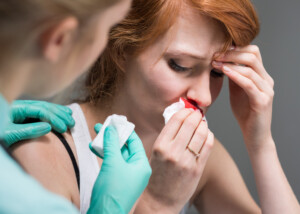
Here’s what a doctor says about the difference between a leukemia nosebleed and a benign one.
If you have a nosebleed out of the blue, no apparent cause, just like that…should you fear this means leukemia?
Or what if you’ve been getting spontaneous nosebleeds lately?
What about the type of bleeding?
Would a leukemia nosebleed necessarily run hard? Or could it just trickle?
Would it necessarily bleed from both nostrils every time?
I brought these questions to Marc I. Leavey, MD, a primary care physician with 40+ years of experience.
Another question I had was if leukemia would make nosebleeds more likely if the person picked his nose or blew it hard, even lightly bumped it.
Dr. Leavey explains, “Rather than respond point by point, let me just expound a bit from what I’ve learned in consultation with learned oncologists in my environment about this matter:
“So you wake up with a nosebleed one morning, don’t feel sick and wonder what could be going on.
“You consult Dr. Google, or if your health plan dictates, Dr. Bing, and OH MY GAWD, I’VE GOT LEUKEMIA. I’M GONNA DIE!!! Hold up fella, not so fast. Let’s look at the whole picture.”
Know Thy Nose
Dr. Leavey explains, “The inside of the nasal cavity is lined with a very thin layer of skin that does not have the protection and resilience that the skin on your face or hand have.
“The slightest trauma to the nose can cause disruption of that mucosal layer. Just under the surface are countless little blood vessels.
“It is those blood vessels that make the lining of your nose look redder than other parts of your body.
“You are seeing those vessels through the very thin mucosa.
“So if you have a forceful sneeze, or pick your nose or otherwise insult your proboscis, those surface vessels may be disrupted and you will bleed.
“From the nose. That’s a nosebleed if you’re not paying attention.”

Even just rubbing a towel on the middle portion of your schnoz as you dry your face after washing it could traumatize minute blood vessels and cause a little blood to trickle out; it’s happened to me.
“The potential severity of the nosebleed depends on the degree of disruption and how well your blood clots,” says Dr. Leavey.
“If it’s not too large of a leak, you will quickly clot it off and may not see any blood from the nose at all.
“On the other hand, a severe tear in a vessel may bleed enough to require medical intervention.
“And it is that ability to clot that is where leukemia enters the picture.
” With many types of leukemia, the normal clotting pathway of the blood is interrupted, for one reason or another.
“So a lesion which might cause only a trickle, if that, in a normal person could cause visible epistaxis (bleeding from the nose), that’s a nosebleed, in an afflicted individual.
“The bleed itself could be from one nostril or two, a trickle or a squirt, hard or easy to control, depending on the circumstances peculiar to that person with that nose at that time.
“The situation is not that dissimilar to those on blood thinners, like warfarin or some of the newer agents, who will have significant bleeding from a seemingly insignificant trauma.
“The takeaway point is that nosebleeds are neither pathognomonic of leukemia, nor does it exclude the diagnosis.
“It would be but one symptom to discuss with your physician if you are having them, and allow the physician to complete an evaluation.
“There are many far more common reasons for nosebleeds than leukemia, from picking your nose to picking a fight.
“In this, as in most other areas of scary symptoms, don’t jump to the worse case first.”
And by the way, significant straining during a heavy deadlift or back squat could trigger a nosebleed due to soaring blood pressure.

Dr. Leavey was formerly with Mercy Medical Center in Baltimore, MD, where his focus was primary care and internal medicine. He has a blog, STRING OF MEDICAL PEARLS.
 Lorra Garrick has been covering medical, fitness and cybersecurity topics for many years, having written thousands of articles for print magazines and websites, including as a ghostwriter. She’s also a former ACE-certified personal trainer.
Lorra Garrick has been covering medical, fitness and cybersecurity topics for many years, having written thousands of articles for print magazines and websites, including as a ghostwriter. She’s also a former ACE-certified personal trainer.













